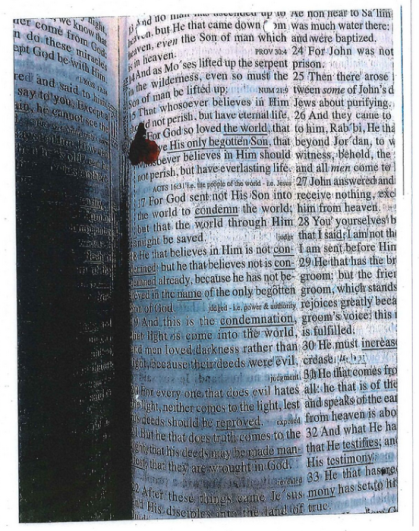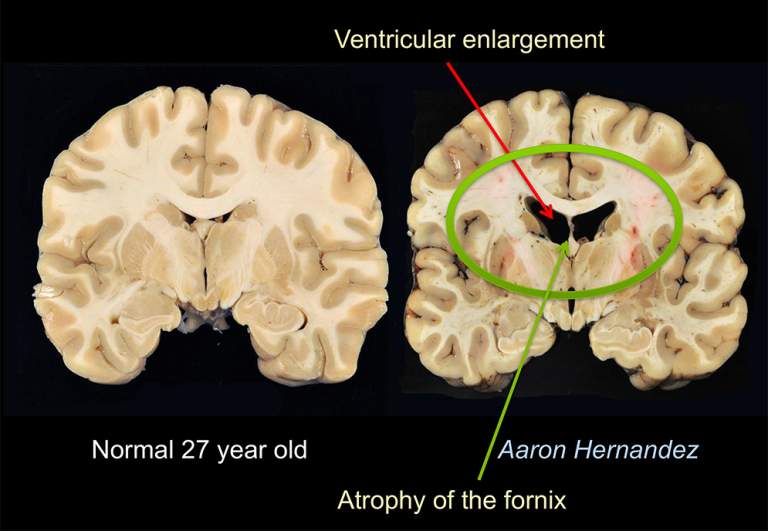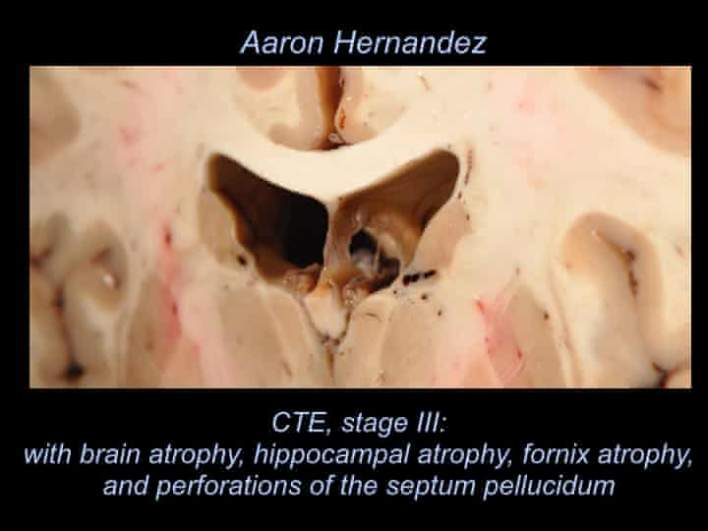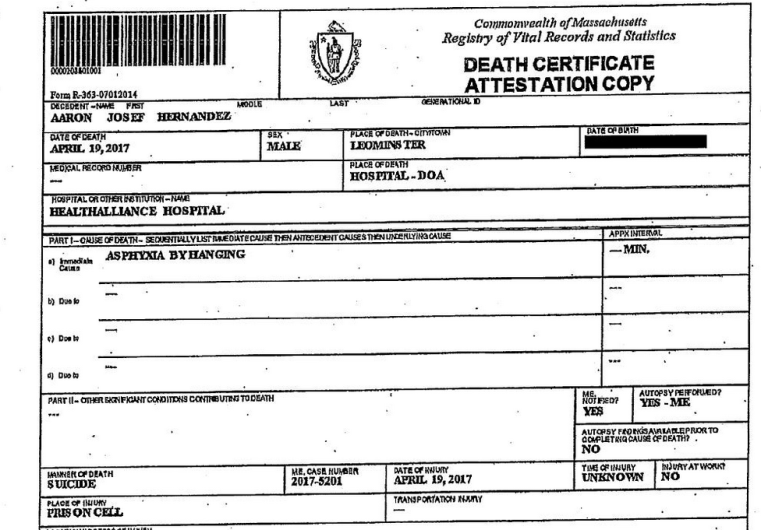
Getty/prison file Aaron Hernandez (l) and a death scene photo (r)
Aaron Hernandez lived dramatically and died dramatically, of suicide in a Massachusetts prison cell, number 57.
His life and death are now the subject of a new Netflix documentary series. Aaron Hernandez committed suicide in his cell, hanging himself with a ligature. However, the death scene contained some bizarre elements, especially when it came to religious reference.
The Netflix documentary series is called Killer Inside: The Mind of Aaron Hernandez, and it streams on January 15, 2020. It explores Hernandez’s complex psychology, including allegations he was molested as a child, a hidden gay lifestyle, and his serious brain injuries from years of damaging blows on the football field.
Hernandez was once flying high; he was a 4th round draft pick with a $40 million contract. However, he was eventually convicted of murdering the boyfriend of his fiancee’s sister, a man named Odin Lloyd. He was also accused of a string of other violent acts, including a double homicide in Boston for which he was acquitted. After his death, brain analysis showed he’d suffered from severe chronic traumatic encephalopathy – the most serious CTE that the researchers had ever seen in someone his age. (You can read about the CTE suffered by former NFL player Junior Seau here. It’s also discussed in the Netflix documentary.)
You can read documents from Hernandez’s prison file here or here.
Here’s what you need to know about what correctional guards found at his death scene, including two photos released in his prison file. You can also see scans of his brain, showing the CTE damage:
Hernandez Was Discovered On April 19, 2017 Hanging in Cell 57 & He’d Placed Cardboard in the Doorway

GettyNew England Patriots tight end Aaron Hernandez
Investigative reports and the prison file provide the details. A Sergeant Smith advised that around 3:03 a.m., a code “99” was called by Correction Officer Gerard Breau reporting Hernandez “was hanged in cell #57.” Other officers arrived and they discovered the door was “pegged,” meaning that cardboard had been shoved into the door tracks to prevent the door from opening.
Officers “had to manually open the door to enter the cell.”
A report from the Massachusetts Department of Correction office of Investigative Services dated May 1 2017 says that, on April 19, 2017 at 3:25 a.m., the Office of Investigative Services was notified that inmate Aaron Hernandez was “found unresponsive” and suspended from a ligature in Cell 57 of the G2 Housing Unit at the Souza-Baranowski Correctional Center (SBCC.)
The report says that Massachusetts State Police Detective Unit assigned to the Worcester County DA’s office and the Office of Investigative Services concluded there “was no indication of foul play.” Autopsy reports found a negative toxicology report and a cause of death as suicide, the report says. Authorities then closed the investigation into Hernandez’s death.
A report from the state police for the Commonwealth of Massachusetts, dated May 4, 2017, gave additional details.
Hernandez Slicked the Floor With Shampoo & Left Behind Bible Verses

A photo from Hernandez’s prison file showing a Bible in his cell.
Guards discovered that Hernandez “had placed a large amount of shampoo on the floor, which made it very slippery,” the state police report continues. The photo above is one of two death scene items photographed in a publicly released prison file.
Guards cut Hernandez down. He was “hanged naked from a bed sheet tied around the window bars.” The report gives these additional details:
Corrections officers began CPR and took Hernandez to the hospital, but he never regained consciousness and a doctor declared him dead at 4:07 a.m. At the hospital, an officer noted that “ligature marks were visible on Hernandez’s neck and there was some discharge/vomit from his nose and mouth area.”
Hernandez Had Written a Bible Verse on His Forehead

Aaron Hernandez in happier days.
The investigative reports give further details on what was found. Aaron’s right middle finger had a fresh cut and there was some blood on the adjacent fingers. “There also appeared to be a large circular blood mark on each of Hernandez’s feet and ‘John 3:16’ was written on Hernandez’s forehead in ink. There were no other signs of trauma or violence on Hernandez’s body.” The Netflix series shows that Hernandez’ former teammate Tim Tebow had drawn John 3:16 on his own forehead during games. It’s not clear whether Hernandez meant that analogy.
The report added “Petechial hemorrhaging was present in both eyes. Lividity was present and rigor mortis was beginning to set in.”
Sgt. Smith advised the police that Hernandez had been locked in his single inmate cell around 7:59 p.m. He remained in the cell until 3:03 a.m., when he was discovered hanged. There was video surveillance of the cell block from the time he entered the cell until the time he was transported. Sgt. Rumery said no one entered the cell until that point.

A Bible found in Aaron Hernandez cell and photographed in his prison file.
On the wall in the cell “were several drawings and John 3:16 written in a substance consistent with blood. Under the drawings was a Bible open to John 3:16, with the 16th verse marked in blood. Next to the Bible were 3 hand written notes.” John 3:16 reads, “For God so loved the world that he gave his one and only Son, that whoever believes in him shall not perish but have eternal life. … For God loved the world in this way: He gave his one and only Son, so that everyone who believes in him will not perish but have eternal life.”
Under the bed was a piece of bed sheet that had been cut and that had been around Hernandez’s neck. Tied on the bars on the window was the other piece of the bed sheet. There were no signs of a struggle in the cell.
Correction Officer Breau said that he last saw Hernandez around 1 a.m. during the 1 a.m. check. Around 3:03 a.m., he observed a sheet hanged in front of Hernandez’s cell door. He asked him to remove it. The sheet fell and he observed Hernandez hanged naked from the window and called a code 99.
WCVB-TV reported that “Hernandez also used his own blood to draw on the walls of his cell.”
“5 Investigates’ Kathy Curran has learned that one of the drawings was what’s known as the unfinished pyramid and the all-seeing eye of God. The image is similar to what is found on the back of U.S. currency,” the station reported. “Below the pyramid, Hernandez wrote ‘ILLUMINATI’ in capital letters.”
Aaron’s Brain Was Riddled With Damage From CTE

BU/Dr. Ann McKeeOne of Dr. Ann McKee’s scan of Hernandez’s brain.
Boston University conducted the research into Hernandez’s brain after his suicide. The university said in a news release that its expert found that Aaron Hernandez “suffered from chronic traumatic encephalopathy (CTE) to a degree never before seen by BU researchers in such a young person.”
His brain was “riddled” with stage 3 CTE to a degree “that we’ve never seen…in our 468 brains, except for individuals very much older,” Ann McKee, director of BU’s Chronic Traumatic Encephalopathy Center, told a news conference in 2017. “Individuals with similar gross findings…were at least 46 years old at the time of death.”

BU/Dr. Ann McKeeOne of Dr. Ann McKee’s scan of Hernandez’s brain.
Hernandez was 27.
According to Boston University, “Chronic Traumatic Encephalopathy (CTE) is a progressive degenerative disease of the brain found in people with a history of repetitive brain trauma (often athletes), including symptomatic concussions as well as asymptomatic subconcussive hits to the head that do not cause symptoms. CTE has been known to affect boxers since the 1920’s (when it was initially termed punch drunk syndrome or dementia pugilistica)…The repeated brain trauma triggers progressive degeneration of the brain tissue, including the build-up of an abnormal protein called tau.”

One of Dr. Ann McKee’s scan of Hernandez’s brain.
“Especially in the frontal lobes, which are very important for decision-making, judgment, and cognition, we could see damage to the inner chambers of the brain,” McKee said. “This would be the first case we’ve ever seen of that kind of damage in such a young individual.”

BU/Dr. Ann McKeeOne of Dr. Ann McKee’s scan of Hernandez’s brain.
Learn more about Aaron’s brain here.
Hernandez Made Phone Calls But Nothing Seemed Amiss

The death certificate from Aaron Hernandez’s prison file.
The surveillance video shows Hernandez was on the phone just prior to being locked in his cell. He enters the cell alone at 7:59 p.m. and the cell door was locked until 307 a.m.
Police listened to the last 5 phone calls Hernandez made. He didn’t make any apparent indication of an intent to harm himself. The autopsy was performed by Doctor Henry Nields. He determined the cause of death was asphyxia by hanging with the manner of death being a suicide.
Letters in the cell were submitted to a handwriting expert who determined that they were written by Hernandez with a “reasonable degree of certainty.”
A suicide note that Hernandez wrote to his fiancée Shayanna Jenkins, the mother of his child, was later released in court.
According to CBS News, it said, in part, “you’re rich” and told her to “tell my story fully, but never think anything besides how much I love you.” He said he wanted her to “live life and know I’m always with you.” You can read the note here.
Hernandez was acquitted of a double murder just five days before he died.
An investigative report indicated that Hernandez was hanging at the rear of the cell from a ligature attached to the window. He was already cold to the touch and stiff with no signs of life. No staff had noted any changes in behavior or routine. This report says he made 7 calls on the evening prior to his death. All content was “future oriented and did not elicit any concerns for safety.”
“Writing on wall in blood with religious imagery and references. Wrote on forehead John 3:16 and appeared to have two circular blood marks…on dorsum of bilateral feet. It appears the blood came from a linear laceration on his right middle finger tip,” that report says.
Another investigative report says Hernandez “had used what appeared to be a bed sheet tightly wound up, fastening one end around the grates of the window and then the other end around his neck.”

Aaron Hernandez
Inmates interviewed said Hernandez “kept to himself, was very spiritual, appeared to be positive, liked to meditate and did not observe him to be acting differently or having any issues.” He was considered “a private inmate who was approachable.”
Inmates didn’t think he seemed depressed. They said he was excited over the weekend after his verdict came down. He was positive and even happily emotional. He played basketball and nothing seemed out of the ordinary. They felt his suicide was some sort of religious message. He had adopted more of a religious tone and stated “remember when you die your soul gets reincarnated.” He also mentioned that he heard a rumor that if an inmate has an open appeal on his case and dies in prison, he is acquitted.
He had been talking about the NFL and going back to play even if it wasn’t with the Pats and talked about his daughter and spending time with her.
You can read Hernandez’s prison incident reports here.
READ NEXT: Aaron Hernandez’s Brain.
Comments
Aaron Hernandez Death Scene: Photos & Details